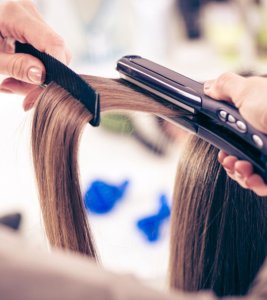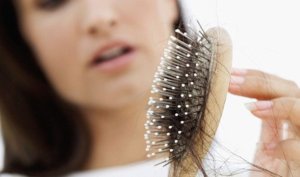Given the innumerable number of people suffering from hair loss amidst the current fast-paced lifestyle, the need to be aware of the dangers and benefits of recent trends in hair care and much-advertised hair care and styling products is relevant. Equally important is to keep your dermatologist informed your use of hair care techniques, especially in light of medical conditions like alopecia or hair loss, says Consultant Dermatologist Dr. Parvathi Padmanabhan…
Hair care includes a spectrum of methods from basic combing to changing the configuration of hair shafts.
A basic set of grooming guidelines for patients with hair loss is as follows:
- Never comb or brush the hair while it is wet.
- Allow the hair to air dry.
- Always use the lowest temperature setting for heated hair appliances.
- Select a wide-toothed, flexible, plastic comb to use for gentle grooming.
- Comb, rather than brush, the hair whenever possible.
- Select a plastic, rounded-lip, coarse brush, if required.
- Avoid the use of tight hair clasps or rubber bands.
- Vary the part line and hair style frequently.
- Select hair styles that place minimal tension on the hair and the scalp.
- Groom the hair only when necessary, keeping manipulation of the hair to a minimum.
- Avoid exposing the hair to wind and sun.
- Handle the hair like a fine silk blouse!
Also read: The basics of winter skin care
Use of hair dryer
A common hair care device found in most households is the hair-dryer. While it is convenient when one is in a hurry, the damage it can cause when used in high frequency and in an improper manner can be quite severe. When the hair shaft is exposed to high temperatures, ‘bubbles’ occur, which lead to small fractures in the shaft, ultimately resulting in irreversible hair damage. It is thus important to:
- Air-dry whenever possible
- Use the lowest heat setting if/when using the dryer
- Hold the dryer at a minimum distance of 12 inches from the hair shaft
- Use an appropriate brush that vents the heat, which tends to build up while drying.
Curling and straightening devices

Another set of electric styling devices that are in vogue is the curling and straightening irons. In this case, the heat that is directly applied to the hair shaft can cause immediate hair damage or significantly increase susceptibility to hair breakage and damage.
Most of these devices work in a temperature range of 100 C – 170 C. Loss of water from the hair at these temperatures increases the readiness at which the hair fractures when pulled. Also, the increased combing force needed for heat-altered hair aids hair damage. Recurrent and prolonged use of direct heat causes extensive damage to hair shaft . This results in bubbling, protein denaturation and splitting of hair, all of which are permanent in nature.
These appliances should be handled carefully as they are capable of inducing second-degree burns on the skin. It is recommended that people with hair loss avoid using such techniques, or when used, to select the lowest temperature setting on the device.
Hair dyes/ colouring
Previously, hair dyeing was restricted to the middle aged group for the primary purpose of covering the greys. Now, the trend has dramatically changed with the use of the same from the early teens for cosmetic purposes. Hair dyeing typically falls into four categories.
- Gradual (color persists with continued use)
- Temporary (color removed from 1 shampooing).
- Semi-permanent (color removed from 4-6 shampooing)
- Permanent (permanent).
Some of the negative effects of repeated and improper hair coloring are dull looking or brittle hair that is unmanageable or hair damage in serious cases. Common problems associated with such procedures are allergic or irritant contact dermatitis.
Also read: Greens for good health
Shampoos and conditioners
Shampoos are intended to clean the hair by removing sebum, sweat components, peeing and flaky skin, oil or other styling products and environmental dirt. Now, all want a shampoo that cleans as well as beautifies. The composition of the shampoos are varied and tall claims are made by the manufacturers to woo the consumer. Your dermatologist will help you choose one.
Since some shampoos remove all the sebum from hair leaving it looking dull, harsh to touch and unmanageable, conditioners are used to bring back the shine and luster to hair by mimicking sebum. They thus reverse hair damage by improving sheen, decreasing brittleness, increasing strength, and temporarily mend split ends. Several types of conditioners are available- instant, deep, leave in and rinse types depending on the extent of hair damage.
Hair styling products
These are used to enhance and maintain an orderly arrangement of the hair and help to add shine, volume and manageability of the hair and include hair sprays, mousses, styling gels, pomade etc. Judicious use of these products enhances cosmetic appearance of hair.
Hair straightening

Fashion fads are largely determined by television shows and ramp shows where straight hair is believed to give a groomed appearance as compared to curly hair, which was “in” a decade ago. Most young adults and a few middle-aged ladies thus flock to beauticians to straighten their hair. Temporary means are hot combing, hair pressing etc where heat breaks the water–reformable bonds and allows the hair to be rearranged structurally for short time. Improper use of hot combs etc can cause permanent hair loss.
Chemical hair straightening uses substances to break the disulphide bonds in the hair shaft and is long lasting technique. Hair loses about 30% of its tensile strength following even a correctly performed procedure. Improper techniques at the hands of an inexperienced or incompetent beautician causes hair loss and breakage that can be permanent
Take home message
With the bombardment from the cosmetics industry about hair care products on one hand and the much advertised “completely safe, done by experienced hands”, hair styling techniques by beauticians, one is bound to be confused and attracted to use products or undergo procedures that may damage your hair and often bite into your pocket as well. Do remember that a hair on the head is worth two in the brush! If you decide to embark on such procedures, choose your cosmetologist/beautician wisely, and seek advice from your dermatologist if in doubt.
